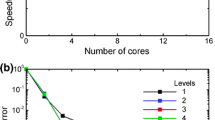Abstract
Numerical analysis is conducted to clarify the formation mechanisms of silicide nanoparticles synthesized in an induction thermal plasma maintained at atmospheric pressure. The induction thermal plasma is analyzed by an electromagnetic fluid dynamics approach, in addition to a multi-component co-condensation model, proposed for the silicide nanoparticle synthesis. In the Cr-Si and Co-Si systems, silicon vapor is consumed by homogeneous nucleation and heterogeneous condensation processes; subsequently, metal vapor condenses heterogeneously onto liquid silicon particles. The Mo-Si system shows the opposite tendency. In the Ti-Si system, vapors of silicon and titanium condense simultaneously on the silicon nuclei. Each system produces nanoparticle diameters of around 10 nm, and the required disilicides, with the stoichiometric composition, are obtained. Only the Ti-Si system has a narrow range of silicon content. The numerical analysis results agree with the experimental findings. Finally, the correlation chart, predicting the saturation vapor pressure ratios and the resulting silicon contents, is presented for estimation of nanoparticle compositions produced in the co-condensation processes.
Similar content being viewed by others
References
M. Sakano, T. Watanabe and M. Tanaka: Numerical and experimental comparison of induction thermal plasma characteristics between 0.5 MHz and 4 MHz. J. Chem. Eng. Jpn. 32, 619 (1999).
M. Sakano, M. Tanaka and T. Watanabe: Application of radio-frequency thermal plasmas to recover materials from fly ash. Thin Solid Films 386, 189 (2001).
M. Shigeta, T. Sato and H. Nishiyama: Numerical simulation of a potassium-seeded turbulent RF inductively coupled plasma with particles. Thin Solid Films 435, 5 (2003).
M. Shigeta, T. Sato and H. Nishiyama: Computational experiment of a particle-laden RF inductively coupled plasma with seeded potassium vapor. Int. J. Heat Mass Transfer 47, 707 (2004).
Japan Society of Mechanical Engineers: Functional Fluids and Intelligent Fluids (Corona Pub. Corp., Japan, 2000), p. 2.
H. Nishiyama and M. Shigeta: Numerical simulation of an RF inductively coupled plasma for functional enhancement by seeding vaporized alkali metal. European Phys. J., Appl. Phys. 18(2), 125 (2002).
S.L. Girshick, C-P. Chiu, R. Muno, C.Y. Wu, L. Yang, S.K. Singh and P.H. McMurry: Thermal plasma synthesis of ultrafine iron particles. J. Aerosol Sci. 24(3), 367 (1993).
T. Watanabe and K. Fujiwara: Control of diameter and yield of silicon dioxide ultrafine particles prepared by radio frequency thermal plasmas. J. Soc. of Inorg. Mater. Jpn. 7, 285 (2000).
M. Shigeta, T. Watanabe and H. Nishiyama: Numerical investigation for nanoparticle synthesis in an RF inductively coupled plasma. Thin Solid Films 457, 192 (2004).
T. Watanabe, A. Nezu, Y. Abe, Y. Ishii and K. Adachi: Formation mechanism of electrically conductive nanoparticles by induction thermal plasmas. Thin Solid Film 435, 27 (2003).
T. Watanabe and H. Okumiya: Formation mechanism of silicide nanoparticles by induction thermal plasmas. Sci. and Technol. Advanced Mater. 5, 639 (2004).
J. Mostaghimi, P. Proulx and M.I. Boulos: An analysis of the computer modeling of the flow and temperature fields in an inductively coupled plasma. Numerical Heat Trans. 8, 187 (1985).
J-F. Bilodeau and P. Proulx: A mathematical model for ultrafine iron powder growth in thermal plasma. Aerosol Sci. Tech. 24, 175 (1996).
M. Desilets, J-F. Bilodeau and P. Proulx: Modelling of the reactive synthesis of ultra-fine powders in a thermal plasma reactor. J. Phys. D: Appl. Phys. 30, 1951 (1997).
K.C. Paul, T. Takashima and T. Sakuta: Copper vapor effect on RF inductively coupled SF6 plasmas. IEEE Trans. Plasma Sci. 26, 1000 (1998).
C. Wang, T. Imahori, Y. Tanaka, T. Sakuta, H. Takikawa and H. Matsuo: Silicon inclusion effect on fullerene formation under induction thermal plasma condition. Thin Solid Films 407, 72 (2002).
X. Chen and L. Pfender: Modeling of RF plasma torches with a metallic tube inserted for reactant injection. Plasma Chem. Plasma Proc. 11, 103 (1991).
J.O. Hirschfelder, C.F. Curtiss and R.B. Bird: Molecular Theory of Gases and Liquids (John Wiley, New York, 1964), p. 484.
R.C. Miller and R.I. Ayen: Temperature profiles and energy balance for an inductively coupled plasma torch. J. Applied Phys. 10, 5260 (1969).
M.I. Hoffert and H. Lien: Quasi-one-dimensional, nonequilibrium gas dynamics of partially ionized two-temperature argon. Phys. Fluids 10, 1769 (1967).
S.V. Patankar: Numerical Fluid Dow and Heat Transfer (Hemisphere, New York, 1980), p. 138.
S.K. Friedlander: Smoke, Dust and Haze, Fundamentals of Aerosol Dynamics 2nd ed. (Oxford Univ. Press, Oxford, U.K., 2000) p. 275.
S.I. Girshick, C.P. Chiu and P.H. McMurry: Time-dependent aerosol models and homogeneous nucleation rates. Aerosol Sci. Technol. 13, 465 (1990).
S.V. Joshi, Q. Liang, J.Y. Park and J.A. Batdorf: Effect of quenching conditions on particle formation and growth in thermal plasma synthesis of fine powders. Plasma Chem. Plasma Proc. 10, 339 (1990).
Japan Institute of Metals: Metal Data Book (Maruzen, Japan, 1993), p. 16.
G.M. Phanse and S.E. Pratsinis: Theory for aerosol generation in laminar flow condensers, Aerosol Sci. Technol. 11, 100 (1989).
T.B. Massalski: Binary Alloy Phase Diagrams, 2nd ed. 3 (American Society for Metals, Materials Park, 1990), p. 2664.
Author information
Authors and Affiliations
Corresponding author
Rights and permissions
About this article
Cite this article
Shigeta, M., Watanabe, T. Numerical analysis for co-condensation processes in silicide nanoparticle synthesis using induction thermal plasmas at atmospheric pressure conditions. Journal of Materials Research 20, 2801–2811 (2005). https://doi.org/10.1557/JMR.2005.0351
Received:
Accepted:
Published:
Issue Date:
DOI: https://doi.org/10.1557/JMR.2005.0351



